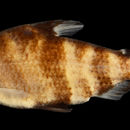en
names in breadcrumbs


Abramites hypselonotus – known as the marbled headstander or the high-backed headstander – is a member of the family Anostomidae[1] of the order Characiformes.[2] Under normal fish classifying rules, the marbled headstander would be classified as a surface dweller. In reality marbled headstanders – like all headstanders – inhabit the middle and lower portions of the aquarium.[3] In the wild, head standers are often found face down, tail up in narrow vertical rocky fissures.[4]
Marble headstanders are generally identified by their high-backed headstander,[5] pointed snout, diamond-shaped body, brown markings on pelvic fin, wavy dark brown bands, and a dark line at the base of the caudal peduncle. The marble headstanders full adult size is roughly 5" (13 cm),[3] on both sides. They are among the rarely introduced representatives of the Anostomidae and the males are more contrasted than the females.[6]
The marbled headstander generally inhabits streams and rivers of the Orinoco and Amazon river systems.[3] Headstanders most commonly inhabit very fast flowing waters in rocky stretches of river.[4]
The marble headstander is a predominantly herbivorous fish and as such should be given a high vegetation diet. In addition to processed food, it will readily accept (and probably enjoy) lettuce leaves, and peas. They will also accept mosquito larvae and bloodworms.[4]
In the aquarium, the marble headstander is known as a peaceful inhabitant. They are completely docile as juveniles both towards other fish and members of their own species. As they get older, they should be kept either as a single headstander or a group of seven or more in a tank as they tend to fight amongst themselves in smaller groups. They are still generally peaceful towards other fish.
Due to the high demand of plant food, robust plants have a small chance of survival due to the sprouting of shoots. A socialization should be done with other great tetras that have similar claims. Keep marble headstanders in a rocky, heavily planted aquarium for them to explore,[4] too small aquariums lead to increased quarrels between conspecifics, which can be avoided by sufficiently offered hiding places with roots and stone structures, consisting of cracks and crevices.[7] If there is not enough vegetation in its diet, it will devour aquarium plants. On the other hand, you can use this to your advantage if you want to set up a "self-sustaining aquarium", please keep in mind that this is not an easy task, do not just throw a bunch of plants in and think it will be fine.[4]
These fish can tolerate a pH from 6–7.5, but prefer slightly acidic water. They like soft water ranging from 2-15 dH, and require a temperature of 73-82 °F (23-28 °C).[7]
Abramites hypselonotus – known as the marbled headstander or the high-backed headstander – is a member of the family Anostomidae of the order Characiformes. Under normal fish classifying rules, the marbled headstander would be classified as a surface dweller. In reality marbled headstanders – like all headstanders – inhabit the middle and lower portions of the aquarium. In the wild, head standers are often found face down, tail up in narrow vertical rocky fissures.